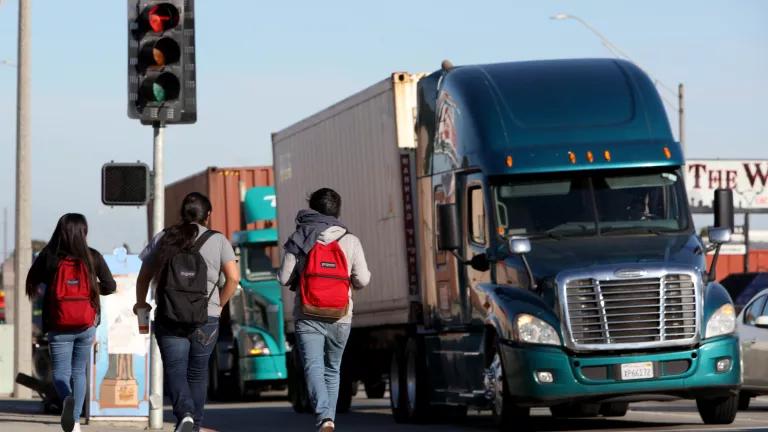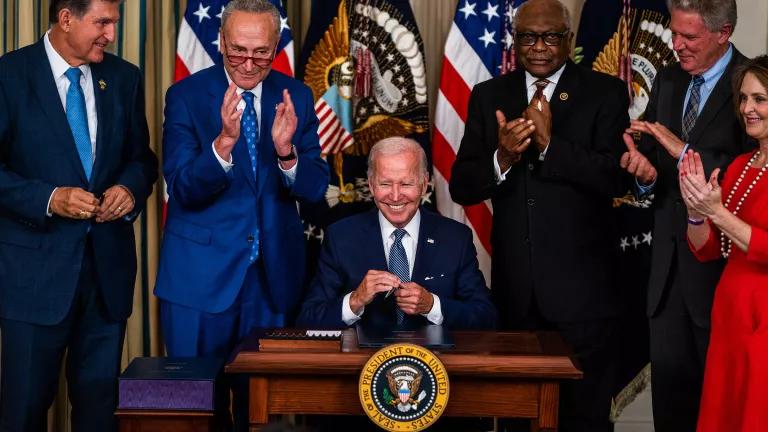California Omnibus Rule Adds Momentum to Cut Truck Pollution

In a major win for the environment, Californians, and the nation, the California Air Resources Board (CARB) voted unanimously today to adopt the Heavy-Duty Omnibus (Omnibus) rule—a comprehensive update to slash toxic air pollution from fossil fuel heavy-duty trucks. And they also adopted the At-Berth regulation to curb emissions from ships idling at port.
Sources of NOx Emissions in California

Facts about the Low NOx Heavy-Duty Omnibus Regulation, California Air Resources Board
Heavy-duty vehicles are the biggest source of oxides of nitrogen (NOx) in California, emitting nearly a third of all NOx pollution, as well as over a fourth of diesel particulate matter (PM). NOx contributes to smog and secondary PM, which, along with primary PM emissions, are associated with increased risk of premature deaths, hospitalization, and ER visits. Numerous respiratory and cardiovascular diseases are linked to these pollutants such as asthma, decreased lung function, heart attacks, and lung cancer.
Cutting NOx and PM emissions from trucking is vital for improving public health and meeting the federal National Ambient Air Quality Standards. Cleaning up truck emissions is long overdue for the communities living adjacent to freeways, ports, and freight hubs that disproportionately suffer from harmful air pollution. Many of these communities, which are predominantly communities of color and low-income communities, see upwards of 1,000 diesel trucks passing through per hour.
Much Needed Reforms Protect Public Health
To realize these emission benefits, the Omnibus rule makes much-needed reforms, such as lowering NOx and PM emission standards, extending manufacturer warranties, and improving emission testing to better align with actual operations and global standards. Moreover, the emission standards derive from nearly a decade of rigorous research and analysis demonstrating that the new requirements are not only technically feasible but cost-effective methods of emissions reduction.
Omnibus Rule NOx Reductions in 2024 and 2027

Facts about the Low NOx Heavy-Duty Omnibus Regulation, California Air Resources Board
The Omnibus rule will cut NOx emissions from heavy-duty trucks by roughly 75% below current standards beginning in 2024 and 90% in 2027. In addition to cleaning up NOx, the Omnibus rule looks to institutionalize PM pollution controls and prevent backsliding by adopting a more stringent standard that aligns with current industry certifications. These reductions add up to $36 billion in statewide health benefits from 3,900 avoided premature deaths and 3,150 hospitalizations from 2022 to 2050.
On top of this, the At-Berth rule that CARB also approved, will pile on additional health benefits. This landmark rule mandates pollution reductions from ships at more ports than ever before, and expands the categories of ships that are regulated, now covering oil tankers and ro-ro vessels for the first time. This rule is projected to save hundreds of Californians from premature deaths and health complications.
Goal Is 100% Zero-Emission Trucks
While the ultimate goal and need is to shift all trucks to zero-emission—and policies like the Advanced Clean Truck rule and commitments by over a dozen states are helping accelerate the zero-emission truck market—more long-lived fossil fuel engines will continue to be built and sold over the next several decades. This new Heavy-Duty Omnibus rule is a vital complement to reduce and ultimately zero-out harmful air pollution from heavy-duty vehicles.
It’s worth noting that numerous states also weighed in to show support for the rule and may exercise their authority under the federal Clean Air Act to adopt California’s new emission standards for heavy-duty vehicles.
Charting a Course for the U.S. EPA
The U.S. Environmental Protection Agency (EPA) is also considering a national truck emission standard. However, due to regulatory requirements, the earliest that rule would come into effect is 2027 and is currently facing additional delays. Needless to say, this date is well beyond when California and other states need to slash emissions. Importantly, the Heavy-Duty Omnibus rule will push manufacturers to innovate and deploy technically feasible and cost-effective emission reduction technology sooner: charting a course for the U.S. EPA to follow.
It’s an exciting time with a lot of great progress being made to curb truck pollution. Now, with this new Heavy-Duty Omnibus rule on the books, we need other states to step up and adopt this rule along with the complementary Advanced Clean Truck rule to jump start our progress to zero-out truck pollution.


